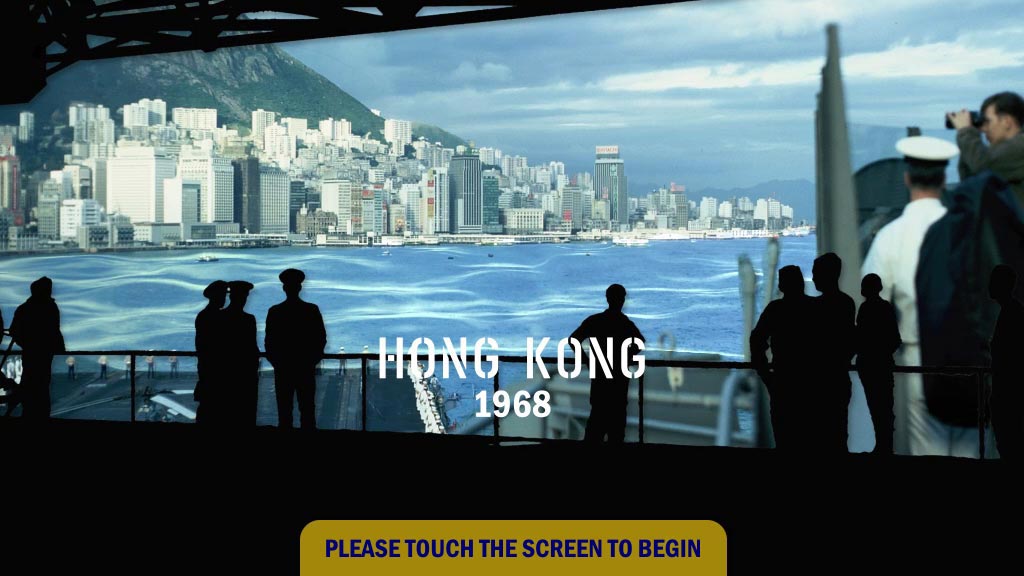The first rule of attract loops is: there are no rules….
In my previous post on the subject, I outlined a variety of attract loop types, from the Prompter to the Curator to the Marketer. Today I’ll take a look at the broader question of just what – if anything – an attract loop ‘should’ be….
Feeling the Burn
When I first started working on experiential media in the late 1990s, attract loops had a very specific purpose: to prevent ‘burn-in.’ Early flatscreen displays, particularly plasma monitors, suffered from this phenomenon, where a persistent image would create a permanent ghost mark on the display, in some cases strong enough to interfere with the media itself. A logo, stuck in the corner of the screen at all times, could became indelible, even after only a few days of operation.
 An attract loop solved this problem through its animation, giving the pixels a break from their always-on status during program operation. As such, attract loops needed to be active enough to refresh every pixel of the display, lest the application destroy the hardware.
An attract loop solved this problem through its animation, giving the pixels a break from their always-on status during program operation. As such, attract loops needed to be active enough to refresh every pixel of the display, lest the application destroy the hardware.
Pro displays soon developed to incorporate automatic burn-in prevention, and today’s display technologies, devoid of phosphor, no longer face the same issue. But the attract loop remains, because you’ve got to put ‘something’ on the screen when it’s not in use….
…or do you? Generally, there are a few core functions that an attract loop might need to fulfill:
- Letting visitors know there’s something to interact with (functional)
- Letting visitors know what that interaction consists of (descriptive)
- Enticing those visitors to interact (persuasive)
Here’s my quick take on each of these:
Functional
I remember about a decade ago seeing a display with a piece of paper taped underneath: “PLEASE DO NOT TOUCH THE SCREEN.” I found this amusing at the time, but visitor expectations have in fact changed due to the prevalence of mobile and tablet devices. Where touch interaction was once a novelty, now it’s an expectation. Lately I’ve seen frustrated visitors trying to use their phone’s swipe and zoom gestures on exhibit displays that didn’t support them.
So do visitors still need to be alerted to the fact that a digital exhibit supports touch? It’s largely a question of context. At a science center or children’s museum, kids will often try touching the screen before even reading what it has to say. At an art museum, or a venue with older visitors, a prompt may be more necessary. The scale and positioning of a display also matters – mounted at a reader rail or counter, one might more likely assume interactivity, whereas a larger, wall-based screen might suggest linear video presentation.
 Case in point: I recently visited an exhibition featuring a giant projection wall of a primeval forest, with the occasional T-Rex stomping through. Per the exhibition brochure, this was an interactive wall… but none of the visitors I observed made an effort to interact, and nothing on-screen suggested that interaction was possible. This larger, unconventional form factor suggested to visitors that this was something to watch, not to play with.
Case in point: I recently visited an exhibition featuring a giant projection wall of a primeval forest, with the occasional T-Rex stomping through. Per the exhibition brochure, this was an interactive wall… but none of the visitors I observed made an effort to interact, and nothing on-screen suggested that interaction was possible. This larger, unconventional form factor suggested to visitors that this was something to watch, not to play with.
As a baseline, I generally like to include at least a simple interaction prompt. It doesn’t take up a tremendous amount of space, and it covers the bases. It’s also polite, helps establish the ‘voice’ of the interactive, and sets a precedent for how it will continue to communicate with the visitor.
Descriptive
How much does the attract loop ‘need’ to communicate the nature of the interaction? Again, of course, this is a question of context. Younger audiences may be inclined to tap any screen out of curiosity, whereas older visitors might need a good reason before they choose to engage.
Even with a curious audience, though, it’s often useful to for an attract loop to identify the nature of both content and interaction that visitors will experience within, so that the second touch (see below) is as enthusiastic as the first.
Persuasive
 Finally, the question of persuasion. This is particularly relevant for brand experiences, where visitors may not have a natural curiosity about the subject matter, but persuasive loops can also come in handy for museum content that is challenging or might be considered boring. An experience that engages users and makes dry content interesting might need to work a little harder to overcome visitors’ initial hesitation.
Finally, the question of persuasion. This is particularly relevant for brand experiences, where visitors may not have a natural curiosity about the subject matter, but persuasive loops can also come in handy for museum content that is challenging or might be considered boring. An experience that engages users and makes dry content interesting might need to work a little harder to overcome visitors’ initial hesitation.
Design can be an important factor in making a persuasive attract loop: Is it colorful and energetic? Sophisticated and tasteful? The tone of the attract loop’s graphics and animation should communicate the personality of the experience, as a way to ‘attract’ the right users. An exhibit designed for K-3 learners doesn’t need to pander to kids with saturated cereal-box colors, but its style can help the right audience self-identify.
Ultimately, one hopes that the interactive experience itself is engaging and relevant; the best attract loops will communicate this experience tonally to make sure it reaches visitors.
The Second Touch
When evaluating digital exhibits, there’s great comfort in watching a visitor tap out of an attract loop to begin an interaction… but too often, that twinge of success falls apart when the visitor glances at the screen and walks away a few seconds later.
 Attract loops can do some of the work to entice visitors, but eliciting the first touch is relatively easy compared with the second, third, fourth, and so on. The relationship between the attract loop and what follows can help alleviate this:
Attract loops can do some of the work to entice visitors, but eliciting the first touch is relatively easy compared with the second, third, fourth, and so on. The relationship between the attract loop and what follows can help alleviate this:
- Be honest – if the attract loop suggests a very different experience than what visitors actually encounter, don’t be surprised by the walkaways. Truth in advertising matters!
- Be concise – tapping an attract loop to reveal paragraphs of text can be a huge turn-off. Let visitors guide themselves to content of interest before throwing too much verbiage in their path.
- Be active – a screen full of instructions can be just as daunting as dense content. If the experience must start with instructions, try making them interactive or animated so visitors can learn by doing.
I’ve been building digital exhibits (and attract loops) for more than 20 years now, and I’ve internalized a sense of what works and what doesn’t work. What I’ve written here is based on my own experience and prejudices – but what’s missing from this article is any real qualitative or quantitative data on the subject.
Fortunately, though, there’s a lot to be garnered from prototyping, observing visitors, and talking to floor staff – and the flexibility of digital media makes it relatively easy to try new approaches to make attract loops as attractive as can be.
And to be clear, there are no ‘rules’ of attract loops – I just couldn’t resist the pun.



One thought on “Rules of Attract Loops, Part 2”
Comments are closed.